|
Stable Inorganic Colloidal Tin and Tin–Lead Perovskite Nanocrystals with
Ultralong Carrier Lifetime via Sn(IV) Control
Yusheng Li, Dandan Wang, Yongge Yang,
Chao Ding, Yuyu Hu, Feng Liu, Yuyao Wei, Dong Liu, Hua Li, Guozheng Shi, Shikai
Chen, Hongshi Li, Akihito Fuchimoto, Keita Tosa, Unno Hiroki, Shuzi Hayase,
Huiyun Wei, and Qing Shen
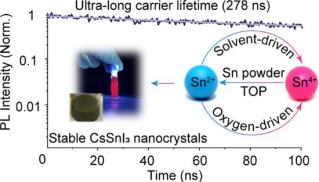
Fig. Stable CsSnI3
nanocrystals exhibit ultralong carrier lifetimes due to Sn(IV) control.
Inorganic tin (Sn) perovskite nanocrystals offer a promising solution to the potential toxicity concerns associated with their established lead (Pb)-based counterparts. Yet, achieving their superior stability and optoelectronic properties remains an ongoing challenge. Here, we report a synthesis of high-symmetry α-phase CsSnI3 nanocrystals with an ultralong 278 ns carrier lifetime, exceeding previous benchmarks by 2 orders of magnitude through meticulous Sn(IV) control. The nanocrystals demonstrate excellent colloidal stability, uniform monodispersity, and a distinct exciton peak. Central to these outcomes is our designed solid–liquid antioxidation suspension of tri-n-octylphosphine (TOP) and zerovalent tin (Sn(0)) that fully addresses the unique coexisting oxygen-driven and solvent-driven Sn oxidation mechanisms in Sn perovskite nanocrystal synthesis. We uncover the largely undervalued function of TOP in mitigating oxygen-driven Sn oxidation and introduce Sn(0) powder to generate a synergistic antioxidation function with TOP, significantly reducing Sn(IV)-induced defects and distortions and contributing to enhanced optoelectronic properties. Strikingly, this approach also profoundly impacts inorganic Sn–Pb perovskite nanocrystals, boosting lifetimes by 2 orders of magnitude and increasing photoluminescence quantum yield over 100-fold to 35%. Our findings illuminate the potential of Sn-based nanocrystals for optoelectronic applications.
See more(click here!)

Energetic disorder dominates optical
properties and recombination dynamics in tin-lead perovskite nanocrystals
Dandan Wang, Yusheng Li, Yongge Yang,
Chao Ding, Yuyao Wei, Dong Liu, Hua Li, Huan Bi, Shikai Chen, Sujun Ji, Boyu
Zhang, Yao Guo, Huiyun Wei, Hongshi Li, Shuzi Hayase, Qing Shen
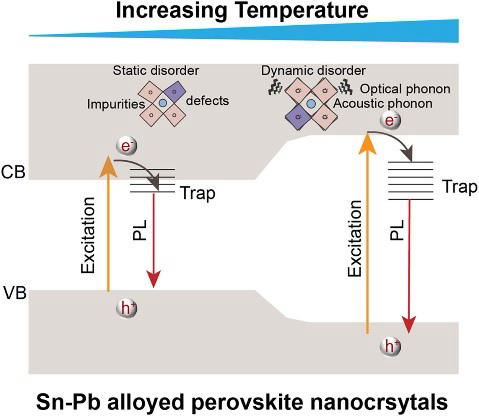
Fig. Energetic disorder
shapes optical and recombination behavior in tin-lead perovskite nanocrystals.
Tin-lead alloyed perovskite nanocrystals (PNCs) offer a
promising pathway toward low-toxicity and air-stable light-emitting devices.
However, substantial energetic disorder has thus far hindered their lighting
applications compared to pure lead-based PNCs. A fundamental understanding of
this disorder and its impact on optical properties is crucial for overcoming
this limitation. Here, using temperature-dependent static and transient
absorption spectroscopy, we meticulously distinguish the contributions of static
disorder (including defects, impurities, etc.) and dynamic disorder
(carrier-phonon interactions). We reveal how these disorders shape band-tail
structure and ultimately influence inter-band carrier recombination behaviors.
Surprisingly, we find that static and dynamic disorder primarily control
band-tail defect states and bandgap renormalization, respectively, which
together modulate fast carrier trapping and slow band-band recombination rates.
Furthermore, we link these disorders to the tin-induced symmetry-lowering
distortions in tin-lead alloyed PNCs. These findings illuminate critical design
principles for highly luminescent, low-toxicity tin-lead PNCs, accelerating
their adoption in optoelectronic applications.
See more(click here!)

Over 15% Efficiency PbS
Quantum-Dot Solar Cells by Synergistic Effects of Three Interface Engineering:
Reducing Nonradiative Recombination and Balancing Charge Carrier Extraction
Chao Ding, Dandan Wang, Dong Liu, Hua
Li, Yusheng Li, Shuzi Hayase, Tomah Sogabe, Taizo Masuda, Yong Zhou, Yingfang
Yao, Zhigang Zou, Ruixiang Wang, Qing Shen
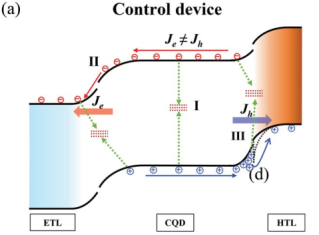
Fig. An innovative
interface modification method developed for the three interfaces of a lead sulfide
colloidal quantum dot solar cell allows precise control of the photogenerated
carriers across the device, balancing carrier extraction while minimizing
nonradiative recombination at each interface of the device, increasing carrier
extraction efficiency at the maximum power point and power conversion
efficiency by over 15%.
Lead sulfide colloidal quantum dot solar cells
(CQDSCs), the next generation of photovoltaics, are hampered by non-radiative
recombination induced by defects and an electron-hole extraction imbalance.
CQDSCs have three interfaces: CQD/CQD, electron transport layer (ETL)/CQD, and
CQD/hole transport layer (HTL), and modifying one of these interfaces does not
fix the problem stated above. Here, coordinated control and passivation of the
three interfaces in PbS CQDSCs are presented and it is shown that the synergistic
effects may improve charge transport and charge carrier extraction balance and
minimize non-radiative recombination simultaneously. A facile method is
developed for epitaxially growing an ultrathin perovskite shell on the CQD
surface to passivate the CQD/CQD interface, resulting in CQD absorber layers
with long carrier diffusion lengths. With the introduction of organic films
with adjustable electrical characteristics, the influence of ETL/CQD
interfacial modifications on carrier transport and recombination is
investigated. An excessive increase in the electron extraction rate reduces the
fill factor and solar efficiency, as discovered. Therefore a modified layer is
created at the CQD/HTL interface to promote hole extraction, which enhances
charge extraction balance and passivates the interface. Finally, PbS CQDSCs
exhibit a power conversion efficiency of 15.45%, a record for Pb chalcogenide
CQDSCs.
See more(click here!)

Stronger Coupling of Quantum Dots in
Hole Transport Layer Through Intermediate Ligand Exchange to Enhance the
Efficiency of PbS Quantum Dot Solar Cells
Yuyao Wei, Chao Ding, Guozheng Shi, Huan
Bi, Yusheng Li, Hua Li, Dong Liu, Yongge Yang, Dandan Wang, Shikai Chen,
Ruixiang Wang, Shuzi Hayase, Taizo Masuda, Qing Shen
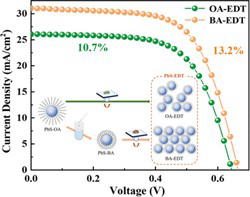
Fig. To solve the problem of volume shrinkage and
inhomogeneous energy landscape, a novel method for PbS-EDT HTL preparation
using small-sized benzoic acid (BA) as intermediate ligands is proposed in this
work. Stronger coupling between QDs and reduced defects in the QD HTL are
realized. Nearly 20% growth in Jsc and a
23.4% higher PCE of 13.2% are achieved.
Nowadays, the extensively used lead sulfide (PbS)
quantum dot (QD) hole transport layer (HTL) relies on layer-by-layer method to
replace long chain oleic acid (OA) ligands with short 1,2-ethanedithiol (EDT)
ligands for preparation. However, the inevitable significant volume shrinkage
caused by this traditional method will result in undesired cracks and
disordered QD arrangement in the film, along with adverse increased defect
density and inhomogeneous energy landscape. To solve the problem, a novel method
for EDT passivated PbS QD (PbS-EDT) HTL preparation using small-sized benzoic
acid (BA) as intermediate ligands is proposed in this work. BA is substituted
for OA ligands in solution followed by ligand exchange with EDT layer by layer.
With the new method, smoother PbS-EDT films with more ordered and closer QD
packing are gained. It is demonstrated stronger coupling between QDs and
reduced defects in the QD HTL owing to the intermediate BA ligand exchange. As
a result, the suppressed nonradiative recombination and enhanced carrier
mobility are achieved, contributing to ≈20% growth in short circuit current
density (Jsc) and a 23.4% higher power conversion efficiency (PCE) of 13.2%.
This work provides a general framework for layer-by-layer QD film manufacturing
optimization.
See more(click here!)

Enhanced Hot-Phonon Bottleneck Effect on
Slowing Hot Carrier Cooling in Metal Halide Perovskite Quantum Dots with
Alloyed A-Site
Hua Li, Qing Wang, Yusuke
Oteki, Chao Ding, Dong Liu, Yao Guo, Yusheng Li, Yuyao Wei, Dandan
Wang, Yongge
Yang, Taizo
Masuda, Mengmeng
Chen, Zheng
Zhang, Tomah
Sogabe, Shuzi
Hayase, Yoshitaka
Okada, Satoshi
Iikubo, Qing Shen
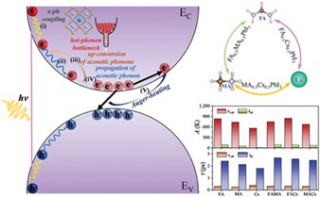
Fig.
The controversies regarding the origins and mechanisms of A-site
cation-dependent hot carrier relaxation dynamics are resolved by comparing the
photogenerated carrier dynamics of 6 kinds of pure and mixed A-site cation
halide perovskite quantum dots (i.e., FAPbI3, MAPbI3, CsPbI3, FA0.5MA0.5PbI3, FA0.5Cs0.5PbI3, MA0.5Cs0.5PbI3 PQDs) at
various excitation intensities.
A deep understanding of the effect of the A-site
cation cross-exchange on the hot-carrier relaxation dynamics in perovskite
quantum dots (PQDs) has profound implications on the further development of
disruptive photovoltaic technologies. In this study, the hot carrier cooling
kinetics of pure FAPbI3 (FA+, CH(NH2)2+), MAPbI3 (MA+,
CH3NH3++),
CsPbI3 (Cs+,
Cesium) and alloyed FA0.5MA0.5PbI3,
FA0.5Cs0.5PbI3,
and MA0.5Cs0.5PbI3 QDs
are investigated using ultrafast transient absorption (TA) spectroscopy. The
lifetimes of the initial fast cooling stage (<1 ps) of all the organic cation-containing
PQDs are shorter than those of the CsPbI3 QDs, as
verified by the electron-phonon coupling strength extracted from the
temperature-dependent photoluminescence spectra. The lifetimes of the slow
cooling stage of the alloyed PQDs are longer under illumination greater than 1
sun, which is ascribed to the introduction of co-vibrational optical phonon
modes in the alloyed PQDs. This facilitated efficient acoustic phonon
upconversion and enhanced the hot-phonon bottleneck effect, as demonstrated by
first-principles calculations.
See more(click here!)

In Situ Room-Temperature Synthesis of
All-Colloidal Quantum Dot CsPbBr3–PbS Heterostructures
Yongge Yang, Dandan Wang, Yusheng Li,
Jing Xia, Huiyun Wei, Chao Ding, Yuyu Hu, Yuyao Wei, Hua Li, Dong Liu, Guozheng
Shi, Yaohong Zhang, Huan Bi, Shikai Chen, Hongshi Li, Xiang-Min Meng, Shuzi
Hayase, and Qing Shen
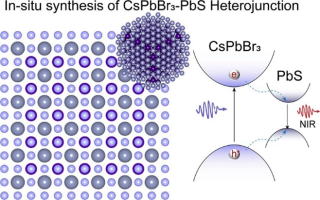
Fig.
Under ambient conditions, we achieved the in-situ synthesis of CsPbBr3-PbS
heterojunctions. The fundamental structure is illustrated in the above diagram
on the left. PbS can in-situ grow on the surface of CsPbBr3 due to their
minimal lattice mismatch. Simultaneously, owing to the chemical bonding at the
heterojunction interface and the type-I energy level alignment, an
exceptionally efficient charge carrier transfer process from CsPbBr3 to PbS
occurs within the heterojunction, as depicted in the above diagram on the
right.
In optoelectronics, all-colloidal quantum dot (all-CQD) heterostructures
featuring processability and extending the functionalities of individual
quantum dots (QDs) have garnered significant attention. Particularly, perovskite
and chalcogenide QD heterostructures present a compelling platform for
integrating visible- and near-infrared spectral responses through effective
carrier transfer. However, a lack of controllable and low-cost synthesis
methodologies currently curtails the development and application of such
intricate structures. Herein, we report a facile and replicable in situ
room-temperature synthesis approach for yielding spectrally tunable, low-cost
processing all-CQD CsPbBr3–PbS heterostructures. This approach utilizes
the controllable growth and high surface reactivity of amine-free CsPbBr3
QDs, together with a highly reactive sulfur source, to facilitate the in
situ formation of heterostructures at room temperature. Our fabricated
all-CQD CsPbBr3–PbS heterostructures possess excellent processability and
showcase sustainable dual emission in both visible and infrared spectra.
The control over which is finely tuned through the manipulation of the
Pb/S ratio. Transient absorption spectroscopy reveals ultrafast interdot
carrier injection (initiating in less than ∼1 ps) from the
perovskite to PbS within the heterostructures, allowing the photons absorbed by
CsPbBr3 QDs to be efficiently provided for PbS’s infrared emission. Based on
their low-cost processability, we debuted their application in short-wave
infrared imaging by harnessing ultraviolet light. We attained a resolution with
a low response threshold of 18 mW/cm2 (365 nm), which approaches the
International Electrotechnical Commission’s safety limit (10 mW/cm2),
significantly surpassing the performance of standalone PbS QDs. Our research
presents a reproducible technique for creating controllable and low-cost
processing all-CQD heterostructures, which sets the stage for future
developments in their application.
See more(click here!)

Simultaneous Characterization of
Optical, Electronic, and Thermal Properties of Perovskite Single Crystals Using
a Photoacoustic Technique
Dong Liu, Hua Li, Yusheng Li, Taro
Toyoda, Koji Miyazaki, Shuzi Hayase, Chao Ding, and Qing Shen
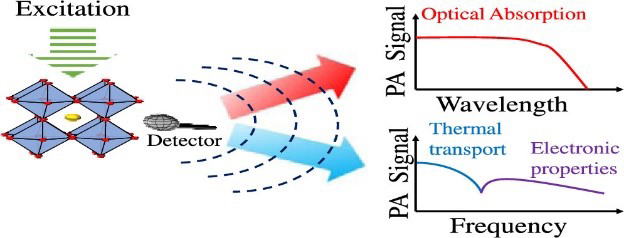
Fig. Acquisition of optical, electronic and
thermal properties of perovskite single crystals by photoacoustic technique.
Metal halide perovskite possesses many excellent
properties beneficial to its potential applications in optoelectronics and
pyroelectricity. Surface recombination velocity, electronic diffusivity, and
excess carrier lifetime accounting for the photoexcited carrier recombination
and electronic transport features are key for improving the performance of
perovskite-based optoelectronic devices. Meanwhile, the thermal conductivity
and thermal diffusivity in halide perovskite have been paid limited attention
despite their potential practical applications such as heat management and
thermoelectric materials. To date, lots of techniques have been developed to
extract these physical properties, while very few of them can effectively and
nondestructively receive the results. The photoacoustic (PA) technique based on
photothermal conversion is a powerful method to study the optical, electronic,
and thermal properties of various materials, especially semiconductor
materials. Optical absorption spectrum, surface recombination velocity,
electronic diffusivity, photoexcited carrier lifetime, and thermal diffusivity
can be obtained simultaneously without the destruction and contact of the
samples. Here, for the first time, we utilized the PA technique in the
perovskite single crystal. Optical absorption of MAPbBr3 and MAPbI3 (MA =
methylammonium) single crystals was investigated under a reflection detection
configuration (RDC), and the electronic and thermal properties were measured
under a transmission detection configuration (TDC). Comparing the results with
previous reports and other characterizations, the PA technique has been
verified to be an efficient and convenient method to study the optical,
electronic, and thermal properties of perovskite single crystals.
See more(click here!)

|